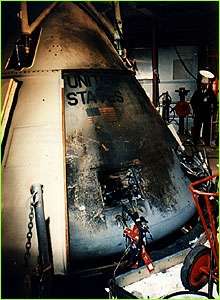Launch Pad Fire Led To Safety Changes In Lunar Program, And
Beyond
 It was an ordinary
Friday evening... January 27, 1967. The Apollo launch team was hard
at work at Launch Pad 34 on Cape Canaveral, running a full dress
rehearsal in anticipation of the Apollo 1 mission, the first manned
mission in the Apollo Program.
It was an ordinary
Friday evening... January 27, 1967. The Apollo launch team was hard
at work at Launch Pad 34 on Cape Canaveral, running a full dress
rehearsal in anticipation of the Apollo 1 mission, the first manned
mission in the Apollo Program.
NASA astronauts Gus Grissom, Edward White and Roger Chaffee were
strapped in their seats in their command module atop a Saturn IB
rocket. Their mission would test this new spacecraft in Earth
orbit. All future Apollo crews would rely on this capsule to see
them safely on their journeys to and from the moon.
Gus Grissom was a local hero -- and one of the original seven
Mercury astronauts selected in 1959. He made the second suborbital
Mercury flight in 1961 and was one of the two-man crew on the
Gemini 3 flight in 1965. Ed White was selected as an astronaut in
1962. He made national headlines as NASA's first spacewalker during
the Gemini 4 mission in 1965. The rookie on the crew, Roger Chaffee
was selected as an astronaut in 1963. Apollo 1 was his first flight
assignment.
It was an exciting time for the National Aeronautics and Space
Administration. Just six years after President John F. Kennedy
issued his declaration that America would land a man on the moon
before the end of the decade, the space agency was within sight of
the first monumental step on that journey.
Until the unthinkable happened, at 6:31 pm. The Apollo 1
vehicle, with the three astronauts locked inside, rocked twice as
the alarm "Fire!" rang out from inside the capsule.
Pad personnel scrambled to reach the White Room -- but when
crews were finally able to open the inner hatch, six minutes after
the first alarms sounded, it was too late. All three astronauts had
died from inhaling carbon monoxide and other toxic gases generated
by the flash fire.
In the accident's aftermath, the NASA family was distraught but
determined to honor their fallen colleagues.
Flight Director Gene Kranz told his team at the Manned
Spacecraft Center in Houston: "From this day forward, Flight
Control will be known by two words: 'tough' and 'competent.'
'Tough' means we are forever accountable for what we do or what we
fail to do," he said. " 'Competent' means we will never take
anything for granted."
An accident review board later determined the fire was caused by
an electrical arc in an equipment bay following a momentary power
outage. The investigation led to major design and engineering
changes, making the Apollo spacecraft safer for the coming journeys
to the moon.
Saturday, a small group of family and friends will gather at Pad
34 at sunset, on the anniversary of the accident to remember these
three dedicated astronauts.
Chaffee's daughter, Sheryl, works as the administrative officer
for Center Operations at NASA's Kennedy Space Center in Florida.
"It has sometimes been hard for me to work here at KSC," she said,
"but I am proud to follow in my father's footsteps as a NASA
employee. He was proud of what he did for his country, and I know
he would support NASA's mission to return men to the moon and on to
Mars."
The NASA family pauses each January for a Day of Remembrance,
honoring the fallen heroes of Apollo 1 (shown below), Challenger
and Columbia and all of those who have given their lives in the
cause of exploration and discovery.

ANN encourages our readership to pause briefly, as well, to
honor the brave men and women who have given their lives in the
ultimate pursuit... the quest for space.
 Airbus Racer Helicopter Demonstrator First Flight Part of Clean Sky 2 Initiative
Airbus Racer Helicopter Demonstrator First Flight Part of Clean Sky 2 Initiative Diamond's Electric DA40 Finds Fans at Dübendorf
Diamond's Electric DA40 Finds Fans at Dübendorf ANN's Daily Aero-Term (04.23.24): Line Up And Wait (LUAW)
ANN's Daily Aero-Term (04.23.24): Line Up And Wait (LUAW) NTSB Final Report: Extra Flugzeugbau GMBH EA300/L
NTSB Final Report: Extra Flugzeugbau GMBH EA300/L Classic Aero-TV: 'Never Give Up' - Advice From Two of FedEx's Female Captains
Classic Aero-TV: 'Never Give Up' - Advice From Two of FedEx's Female Captains




